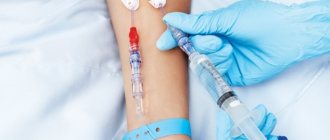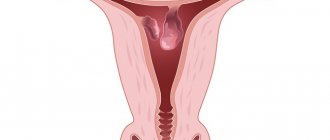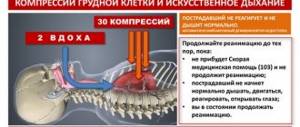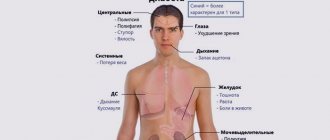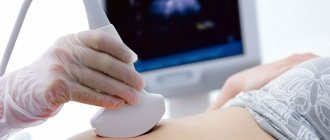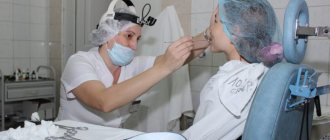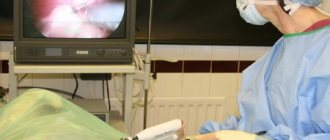Many people cannot live without constant physical activity. By maintaining an active lifestyle, they improve health and, by maintaining youth for a long time, prolong life. When people undergo surgery, their daily routine is disrupted and they are forced to limit themselves during the post-operative recovery period. The main issue is the duration of rehabilitation, since they cannot fully train.
The cecum, as part of the digestive system, is involved in the process of digesting food. The vermiform appendage of the cecum is called the appendix. For a long time it was considered an atavism, since, being part of the digestive tract, it does not participate in its work. Modern research claims that the appendix plays an important role in the immune system - the cells it produces protect the intestines from foreign aggressive bacteria.
Appendicitis is an inflammation of the appendix of the cecum. The causes of the pathology have not been established - anyone can get sick. As a treatment, medicine offers the only option - emergency surgery.
Removal of the appendix of the cecum is the most common medical operation in the world. Timely diagnosis of the disease and provision of medical care will reduce the likelihood of dangerous complications and allow you to recover as quickly as possible. Therefore, at the first suspicion of appendicitis, you should immediately contact a medical facility.
What are the restrictions in the postoperative period?
The risk of possible complications is associated not with the removal of the inflamed appendix, but with damage to the abdominal wall. Traditional abdominal surgery involves creating an incision in the groin area, the size of which will reach 9-10 cm. This is a serious violation of the integrity of the anterior abdominal wall, so any physical activity during the period of rehabilitation of the disease should be limited. Failure to comply with medical recommendations can lead to the development of complications such as suture dehiscence or the appearance of a hernia.
Today, appendectomy is more often performed laparoscopically, through 2-3 small incisions 1.5-2 cm long. The patient recovers faster and easier after such an operation, but physical activity should also be excluded in the first weeks after the intervention.
Exercise therapy after surgery (appendectomy): features
Exercise therapy after surgery to remove the inflamed appendix is particularly dynamic, since with an uncomplicated course of the postoperative period, the patient’s condition literally improves every hour.
Thus, exercise therapy after appendectomy should begin with breathing exercises followed by “painless” coughing: holding the postoperative wound with his hands, the patient inhales as deeply as possible through the nose - and then exhales in the form of several cough shocks. At the same time, the instructor compresses the chest in various parts synchronously with cough shocks. It is noteworthy that, without thinking at all about carrying out exercise therapy after surgery, this exercise is often carried out by anesthesiologists, after bringing patients out of anesthesia - that is, literally in the first minutes after surgery!
After surgery, a “victim of appendicitis” can, of course, do exercise therapy not only under the supervision of an instructor, but also independently. This is especially true in clinics where physical therapy methodologists (instructors) are either not present on staff at all, or are represented by “small forces” and do not have the opportunity to work with each patient individually. In this case, carrying out exercise therapy after surgery on the abdominal organs theoretically becomes the concern of the medical staff of the abdominal surgery department. However, in the vast majority of medical institutions in Ukraine, the workload of doctors and nurses is such that in fact, all physical therapy after appendectomy usually comes down, at most, to teaching patients the correct technique for getting out of bed and a list of “forbidden” movements.
This situation can be partially corrected by familiarizing patients with approximate sets of exercises, the implementation of which is recommended as part of exercise therapy after surgery (appendectomy), depending on the day of the postoperative period, provided that its course is uncomplicated.
Bed rest is an important stage of rehabilitation
Successful surgery for uncomplicated catarrhal or phlegmonous appendicitis does not require long-term bed rest. Within 5-6 hours after appendectomy, patients can and should walk. Early verticalization will help stimulate intestinal motility and restore digestive processes.
Forms of acute appendicitis, complicated by suppuration, abscess formation, gangrene or perforation, keep the patient in a supine position longer - for 1-2 days. How long bed rest will last for a patient in each specific case depends on many factors and is determined by the attending physician individually. Such patients should increase physical activity gradually, taking the first steps with the support of relatives or clinic staff.
Early postoperative period: what is possible and what is not
The time spent in the hospital after appendicitis ranges from 3 days to several weeks. All this time, patients are under the supervision of medical workers. What can be done during this period, and what is strictly prohibited?
- eat liquid and pureed food, which will not “load” the intestines with unnecessary work;
- walk slowly with rest breaks;
- lie down and rest more.
Is it possible to swim immediately after surgery? Traditional water procedures are prohibited, but it is important to perform hygiene of certain areas of the body twice a day. Avoid getting water into the incision site until the stitches are removed and a permanent scar has formed.
In the early postoperative period you cannot:
- walk or run quickly;
- stay in a standing position for a long time;
- lift weights;
- engage in any kind of sports.
What physical activity is permissible after appendicitis removal?
Removal of the appendix of the cecum is one of the most frequently performed operations in the world.
Despite the fact that every doctor is fluent in appendectomy, and this method of surgical intervention practically does not cause complications, it imposes certain restrictions on patients in the postoperative period.
Why physical activity is limited after removal of appendicitis, and when you can return it to your life in full: let’s try to figure it out.
What are the restrictions in the postoperative period?
The risk of possible complications is associated not with the removal of the inflamed appendix, but with damage to the abdominal wall. Traditional abdominal surgery involves creating an incision in the groin area, the size of which will reach 9-10 cm.
This is a serious violation of the integrity of the anterior abdominal wall, so any physical activity during the period of rehabilitation of the disease should be limited.
Failure to comply with medical recommendations can lead to the development of complications such as suture dehiscence or the appearance of a hernia.
Today, appendectomy is more often performed laparoscopically, through 2-3 small incisions 1.5-2 cm long. The patient recovers faster and easier after such an operation, but physical activity should also be excluded in the first weeks after the intervention.
Successful surgery for uncomplicated catarrhal or phlegmonous appendicitis does not require long-term bed rest. Within 5-6 hours after appendectomy, patients can and should walk. Early verticalization will help stimulate intestinal motility and restore digestive processes.
Forms of acute appendicitis, complicated by suppuration, abscess formation, gangrene or perforation, keep the patient in a supine position longer - for 1-2 days.
How long bed rest will last for a patient in each specific case depends on many factors and is determined by the attending physician individually.
Such patients should increase physical activity gradually, taking the first steps with the support of relatives or clinic staff.
Early postoperative period: what is possible and what is not
The time spent in the hospital after appendicitis ranges from 3 days to several weeks. All this time, patients are under the supervision of medical workers. What can be done during this period, and what is strictly prohibited?
Patients are allowed:
- eat liquid and pureed food, which will not “load” the intestines with unnecessary work;
- walk slowly with rest breaks;
- lie down and rest more.
Is it possible to swim immediately after surgery? Traditional water procedures are prohibited, but it is important to perform hygiene of certain areas of the body twice a day. Avoid getting water into the incision site until the stitches are removed and a permanent scar has formed.
In the early postoperative period you cannot:
- walk or run quickly;
- stay in a standing position for a long time;
- lift weights;
- engage in any kind of sports.
Return to an active life
After discharge from the hospital, the patient is transferred to outpatient treatment. His physical activity regime will remain gentle for another 1-3 months. This means that any intense exercise is completely prohibited: lifting weights, running, and having sex are not allowed. All types of professional sports are not allowed.
Patients can perform normal household activities. Slow, leisurely walking (excluding the need for prolonged standing), ordinary housework, and lifting objects weighing up to 3 kg will not harm. Full sexual activity is allowed 1-2 weeks after the sutures are removed.
The return to usual physical activity should be gradual and be guided by the following rules:
- First, light exercises are performed, and then, in the absence of pain and other unpleasant sensations, you can move on to more complex ones.
- Complex exercises are performed without additional weight.
- Loads on the muscles of the anterior abdominal wall and sudden bends forward and to the sides are completely eliminated.
- If you experience the slightest discomfort while performing exercises, you should immediately stop them and seek medical help.
Physical therapy exercises performed from the fourth day after surgery
Already from the fourth day, the set of exercises expands. The patient can attend group fitness classes and walk up the stairs. In addition, on the 5th day the sutures are removed and, if the wound has healed, the patient is discharged the next day.
Physical exercises are performed standing:
- Inhaling, raise your arms straight up, holding them in front of you. Exhaling, spread to the sides and lower along the seams (5 repetitions).
- Spread your legs, place your hands on your shoulders. Rotate your shoulders 10 times forward and 10 times back.
- Hands at your sides. Bend the upper body to the right and left, returning to the starting position (8 repetitions).
- Hands on hips. Rotate your pelvis 4 times clockwise and 4 times counterclockwise (10 repetitions).
- Hands on hips. Inhaling, turn your upper body to one side and extend your arm. Exhaling, take the starting position. Then perform a turn in the other direction (8 repetitions).
- Hold the support with your hands, legs together. Alternately move your legs to the sides, at least 7 times.
- Hands at your sides. Place your hands behind your head and lift one leg, bending it at the knee. Then take the starting position and repeat the exercise with the other leg (8 repetitions).
- Place your right hand on the navel area and your left hand on your chest. Inhaling, slowly push your stomach out, while exhaling, slowly draw it in (8 repetitions).
- Stand with your back to the chair and raise your arms. Exhaling, sit on it and lower your arms, inhaling - stand up (6 repetitions).
It is also useful to throw a ball at some surface and catch it. There is no need to make sudden movements.
A week after surgery, you can lead a full life while continuing to do exercises. The only restriction is a ban on lifting weights for 2-3 months.
Sports after appendicitis - what is possible and what is not?
It all depends on the form and stage of the disease. During simple catarrhal appendicitis, patients can rise or change position after 4-6 hours. This greatly improves the condition of the intestines, preventing the formation of adhesions.
In cases where appendicitis is gangrenous or complicated by peritonitis, patients remain in bed for 2 days. After this time has passed, you can move with the help of staff.
During the postoperative period, it is recommended not to do any physical activity. For a month, it is not recommended to lift heavy objects or stand for a long time. There is no need to perform fast movements, especially with jerks. Failure to comply with such simple conditions will result in the seams coming apart.
What can you do on the first day after surgery?
After appendicitis, during the first day, patients need to be in bed rest. It is recommended to use painkillers at first. If the operation was performed using laparoscopy, then the consequences are easier to bear. Patients are able to return to normal rhythms of daily life more quickly.
After a two week period
If about two weeks have passed since surgery, then lifting weights of more than 3 kilograms is contraindicated. It is not recommended to kneel for a long time. Also, it is contraindicated to do long-term and constant loads. They increase pressure in the lower abdomen, and at some point the stitches will come apart. After two weeks it is not recommended to do any sports activities.
Three months after appendicitis removal...
To maintain shape, sports activities are recommended to strengthen the limbs. Under no circumstances should you strain your abs or any abdominal muscles during the three-month period.
To properly maintain shape so that the course of the disease does not increase, it is important to carry out special exercises. In any case, the system should be selected so that there is no stress on the abdominal muscles.
It is recommended to avoid running. Such training is replaced by elements of calm walking, as well as exercises to strengthen the muscles of the arms and legs. It is not recommended to completely abandon physical activity completely. Such actions lead to the development of adhesions in the intestines and the operated area.
Three months after the operation, you can start lifting weights: dumbbells or barbells. But this is done only when three months have passed and the patient has no complications.
You need to give up:
As for patients who were operated on using laparoscopy methods, they are rehabilitated faster. You can start exercising after two months.
Exercise therapy on the first day after appendectomy
Within a few hours after surgery, the patient must be taught to roll over and sit up correctly. At first, the help of medical personnel or loved ones is required. In order to sit down, the patient must perform the following steps in turn:
- bend your knees, placing your feet on the bed;
- place emphasis on your elbows and feet and slightly lift your pelvis off the bed;
- move the pelvis to the edge of the bed from which you should get up;
- move your feet to the same edge;
- place your legs, bent at the knees, on the side on which you need to stand so that your knees hang off the bed;
- placing emphasis on your elbow, raise your shoulder and turn onto the same side;
- when the whole body is turned on its side, you should rest a little;
- Helping yourself with your hands, carefully lower your legs from the bed;
- push off with your elbow and slowly sit down.
On the day of the operation, you can already perform exercises. All of them are performed lying on your back and are aimed at general restoration of the body and breathing:
- Pull your toes towards you and away from you, approximately 8 repetitions.
- Bend and straighten your fingers, at least 8 repetitions.
- As you exhale, place your hands on your shoulders so that your elbows point to the sides; while inhaling, place your hands at your sides.
- Inhale and place your hands at your sides, palms facing up. Exhaling, slowly raise your arms, open your palms and stretch them towards your feet. Don't lift your shoulders off the bed. Perform 3 repetitions.
- Take a few slow breaths and relax your body.
- Bend your knees and spread them (your feet are on the bed). Exhale and lift your pelvis off the floor, focusing on your feet, elbows and shoulders. Inhale and take the starting position.
- The starting position is the same. Place a heating pad with lukewarm water on your lower abdomen. Exhaling, raise the heating pad to the top of your abdomen, inhaling and lowering it down.
The body must be protected
Rehabilitation after surgery is the key to proper recovery. Their attending physicians should tell patients when they can exercise.
The fact that no complications appeared is evidenced by the condition of the sutures during their removal. If no illnesses or changes are observed, then you can gradually begin physical activity.
When training, many patients themselves must monitor the condition of their stitches. It is important that no substances, including water, get there. This may cause complications. It is not recommended to ignore the advice of experts.
What can a child do after appendicitis: games, activities
The restrictions are minimal, but it all depends on the condition of the baby and the number of days that have passed since the operation. The more time has passed, the fewer restrictions there are. During the first time, feeling pain, the child himself is unlikely to want to engage in any physical activity. And later, when his mood improves, many taboos will no longer be relevant. Even if the temperature remains at 37C, the child is allowed to do his usual activities - play, draw, and so on. Physical activity, as well as sports activities that affect the abs, are, of course, still prohibited. You should consult your doctor about when your child can return to them.
After removal of the appendix and discharge from the hospital, it is recommended:
- For 7-10 days, stay at home (do not attend kindergarten or school);
- be sure to see a surgeon at your local clinic;
- measure body temperature for 4-5 days (to track the possible onset of inflammation);
- monitor nutrition: do not overfeed, give the child light foods (vegetable soups, thin cereals) that do not burden digestion;
- if the surgery was performed using a traditional incision, you will need to ensure that the child does not lift heavy objects in the first month after the operation;
- exemption from physical education after abdominal surgery can be extended for 2-3 months;
- if laparoscopic surgery was performed, then physical restrictions may be minimal (no more than 1 month), since small wounds heal much faster.
People who are used to leading an active lifestyle are concerned about when can they play sports after appendicitis? Physical activity is useful and necessary for people, but it is better to avoid it in the postoperative period. How long it will take for the body to fully recover after removal of appendicitis depends solely on the type of operation and the general condition of the patient. In any case, only the attending physician can give the go-ahead to exercise, after assessing the patient’s well-being and test results.
IT IS IMPORTANT TO KNOW! Even a “neglected” gastrointestinal tract can be cured at home, without surgery or hospitals. Just read what Galina Savina says and read the recommendation.
Summarizing
Only careful planning of all actions leads to positive results. With their help, you can quickly return to your normal way of life.
It is important to understand that you can return to your previous way of life, but haste is just inappropriate here. Any mistake can cause serious consequences.
Many people cannot live without constant physical activity. By maintaining an active lifestyle, they improve health and, by maintaining youth for a long time, prolong life. When people undergo surgery, their daily routine is disrupted and they are forced to limit themselves during the post-operative recovery period. The main issue is the duration of rehabilitation, since they cannot fully train.
The cecum, as part of the digestive system, is involved in the process of digesting food. The vermiform appendage of the cecum is called the appendix. For a long time it was considered an atavism, since, being part of the digestive tract, it does not participate in its work. Modern research claims that the appendix plays an important role in the immune system - the cells it produces protect the intestines from foreign aggressive bacteria.
Appendicitis is an inflammation of the appendix of the cecum. The causes of the pathology have not been established - anyone can get sick. As a treatment, medicine offers the only option - emergency surgery.
Removal of the appendix of the cecum is the most common medical operation in the world. Timely diagnosis of the disease and provision of medical care will reduce the likelihood of dangerous complications and allow you to recover as quickly as possible. Therefore, at the first suspicion of appendicitis, you should immediately contact a medical facility.
When can you exercise after appendectomy?
Many people are unable to imagine life without stress. They often ask themselves the question of how long they can’t exercise after having their appendix removed. What to do if such a nuisance happens.
After all, inflammation can happen at any unforeseen moment, and no one is protected from this.
A sign of the disease is pain in the lower abdomen, on the right. Sometimes, patients' symptoms are supplemented by nausea, constipation and vomiting.
With inflammation, the patient has no appetite.
Sports after appendicitis - what is possible and what is not?
It all depends on the form and stage of the disease. During simple catarrhal appendicitis, patients can rise or change position after 4-6 hours. This greatly improves the condition of the intestines, preventing the formation of adhesions.
In cases where appendicitis is gangrenous or complicated by peritonitis, patients remain in bed for 2 days. After this time has passed, you can move with the help of staff.
During the postoperative period, it is recommended not to do any physical activity. After surgery for appendicitis, it is not recommended to lift heavy objects or stand for a long time for a month. There is no need to perform fast movements, especially with jerks. Failure to comply with such simple conditions will result in the seams coming apart.
Permissible types of loads after surgery
Physical activity after removal of appendicitis should be gentle.
In order to recover from surgery as quickly as possible, but without harming the body, you should adhere to the following recommendations:
- Always start with minimal loads. If these are walks, then let them last 10 minutes a day at first. Over time, as your health improves, their duration can be increased.
- After abdominal surgery, you need to choose non-active sports that will simultaneously help strengthen the muscles of the whole body. The best choice in such a situation is yoga and Pilates. The latter is most preferable, since it was originally developed as a gymnastics for the recovery of patients after severe operations and physical injuries. When exercising, preference should be given to exercises that do not affect the abdominal area. Such classes can be introduced over time, when the risk of complications is over.
- You should avoid active sports, as well as exercises aimed at working your abs. This can be all kinds of bending, twisting, lunging. You can return to them later. The main attention should be directed to working out the limbs and strengthening the whole body.
- An important point is that lifting barbells and dumbbells is also prohibited for at least six months after surgery. You cannot lift weights more than 3 kg, this applies not only to sports, but also to everyday life.
- As you recover, you can start dancing, running and jumping. Such exercises increase the overall endurance of the body. In this case, the press is not directly involved.
Playing sports when there are no complications
It is necessary to comply with the requirements of restrictions on physical activity for proper scarring of the operated area, preventing the sutures from coming apart. Also, load restrictions must be observed to prevent the formation of hernias.
Dancing, yoga, swimming or jumping is prohibited. This also applies to running. As for the abdominal muscles, no load should be applied to them.
Compliance with the rules during physical activity
- Go to the gym only after your doctor allows it.
- Lifting heavy objects at home is prohibited, especially if the wound is healing poorly.
- It is recommended to perform simpler exercises at first. It is recommended to avoid strong bends forward or backward.
- It is not recommended to pump up the press using additional weight.
- A gradual increase in load can be done only after more than 8 weeks have passed.
- Exercises of high complexity should be performed with minimal weights.
- If discomfort appears during training, then you should interrupt the training without any delay and contact a specialist.
Types of physical activity
Patients who have undergone surgery to remove the appendix are required to have a recovery period, the correctness of which determines the success of the entire treatment. During rehabilitation in the life of a patient who has undergone an appendectomy, the following types of activities are allowed:
- yoga;
- Pilates;
- jumping;
- dancing;
- run;
- gymnastics;
- swimming;
- fitness.
The choice of classes is based on the patient’s condition and the complexity of the surgical intervention. Thus, you cannot perform loads if abdominal surgery was performed, the patient needed resuscitation, and antibiotics were used. In this case, any sport, even the easiest one, can negatively affect the course of the rehabilitation period.
The body must be protected
Rehabilitation after surgery is the key to proper recovery. Their attending physicians should tell patients when they can exercise.
The fact that no complications appeared is evidenced by the condition of the sutures during their removal. If no illnesses or changes are observed, then you can gradually begin physical activity.
When training, many patients themselves must monitor the condition of their stitches. It is important that no substances, including water, get there. This may cause complications. It is not recommended to ignore the advice of experts.
What are the restrictions in the postoperative period?
The risk of possible complications is associated not with the removal of the inflamed appendix, but with damage to the abdominal wall. Traditional abdominal surgery involves creating an incision in the groin area, the size of which will reach 9-10 cm.
This is a serious violation of the integrity of the anterior abdominal wall, so any physical activity during the period of rehabilitation of the disease should be limited.
Failure to comply with medical recommendations can lead to the development of complications such as suture dehiscence or the appearance of a hernia.
Today, appendectomy is more often performed laparoscopically, through 2-3 small incisions 1.5-2 cm long. The patient recovers faster and easier after such an operation, but physical activity should also be excluded in the first weeks after the intervention.
Features of wound healing
Suture after appendicitis is an important postoperative moment. After what time the stitches are removed and how many days the wound heals are also pressing questions. A suture is the connection of tissues after surgery. They are internal and cutaneous. The former connect the abdominal muscles, and the latter connect the cut skin.
The photo shows the appearance of a suture after appendicitis. It is located above the pubic area on the right and has a length of up to 10 cm. The surfaces of the skin suture are hard. When stitching, threads are used that are absorbable after surgery (for internal sutures) and those that need to be removed.
Source: https://polic-5.ru/neotlozhka/zanyatiya-sportom-posle-appendicita.html
Methods of surgical treatment
In surgery, two main methods are used to remove the appendix: open appendectomy and laparoscopy.
In the first case, the surgeon makes a 10-centimeter incision in the abdominal cavity. This is significant damage to the integrity of the abdominal wall, so its healing takes a long time. During laparoscopy, the integrity of the abdominal wall is slightly violated - three punctures are made, each 2 centimeters in size. After this method, healing of the wound surface and internal tissues proceeds more easily. In both cases, patients are advised to rest completely for 24 hours and take painkillers for the next two days after the surgical procedure.
Factors influencing recovery time
After doctors cut out the affected appendix, a disruption in the functioning of the body’s functions occurs: digestion slows down, respiratory function is depressed, and general tone decreases.
The length of the recovery period after appendicitis is determined by various factors:
- Individual characteristics of a person - gender, age and weight;
- Accompanying illnesses;
- Reaction to anesthesia;
- Type of surgery: laparoscopy or open method;
- Stage of the inflammatory process.
Young people recover faster than older people and children. Postoperative complications and severe stage of the disease require additional efforts to combat possible infection. Physical activity after removal of appendicitis is under strict medical supervision.
Additional restrictions
The operation to remove the appendix belongs to the category of simple and non-traumatic procedures. In rare cases, the following complications may occur:
- Problems with urination;
- Cardiac dysfunction caused by blood loss;
- Infection due to violation of hygiene rules;
- Inflammatory process of internal organs;
- Negative effects of anesthesia;
- Adhesions and obstruction of the intestinal tract.
They are due to two factors:
- The disease was diagnosed at an advanced stage;
- Failure to comply with the recommendations of the attending physician.
In each case, drug treatment is prescribed in combination with physiotherapy and therapeutic exercises.
In severe situations, repeated surgery is performed. If complications occur after an appendectomy, sports are allowed after six months, and heavy lifting is allowed twelve months after the operation. In such conditions, constant wearing of a bandage is recommended to prevent tension in the suture area.
Features of the event
How long after you can start playing sports after appendix removal depends on the type of surgery. If laparoscopy was performed, which is a surgical method in which the intervention is carried out through small holes, while traditional appendectomy requires large incisions, then you should refrain from exertion for 30 days. This time is enough for wounds to heal, muscles to recover, and no problems in the form of lumps or lumps to arise. A patient who has undergone abdominal surgery to remove the appendix should be more careful with physical activity and completely abandon it for the first time.
In any case, after appendicitis you need a gentle regime for at least a month, more complex exercise is prohibited for 3 months. These restrictions are due to the need for complete scarring of the sutures and healing of the wound. People who have undergone surgery to remove appendicitis need to start an active life with walking in the fresh air. In addition, visiting the pool is allowed, and it is better to postpone fitness for a while.
Physiotherapy
A mandatory element of rehabilitation is a course of physical therapy (PT), aimed at preventing postoperative deterioration of the patient’s condition: pneumonia, thrombophlebitis, increased gas formation and constipation. With this course, swelling is reduced, regenerative processes are stimulated and pain is reduced.
Patients immediately after surgery begin to perform physical therapy exercises. The course of treatment begins with breathing exercises, later the emphasis shifts to working the muscles of the arms and legs.
Diet
To successfully overcome the consequences of the procedure, the patient is prescribed a diet. After 24 hours, food intake is allowed. It is recommended to eat liquid or pureed food in small portions six times a day. Food is taken chilled to prevent irritation of internal organs. Products that cause increased gas formation in the intestines are excluded from the diet: legumes, salty or smoked foods, soda, mushrooms. Alcohol, smoking and salt are prohibited. Rehabilitation includes giving up baked goods. The diet is followed for two months, after which patients gradually return to their usual foods.
Sick leave
During the recovery period, doctors prescribe rest and home regimen. During this time, people are entitled to sick leave. The duration of treatment is determined by the person’s condition and the nature of the work. When the condition normalizes, patients are discharged, but with restrictions on physical activity. Schoolchildren are exempt from physical education.
When visiting a doctor, consult carefully. Persistently ask about your health status, answer your doctor's questions honestly, follow all recommended restrictions, and do not create additional health risks for the sake of wanting to immediately return to sports training.



